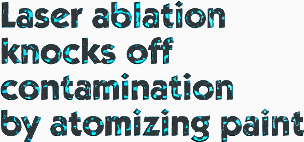

 F2 Associates, Inc. of Albuquerque, New Mexico has demonstrated a fast, clean, dry paint-removal system that, with the first pass of a pulsed laser beam over a surface painted with lead-based paint, removes enough lead to almost meet standards for residual surface lead in day-care centers set by the Department of Housing and Urban Development. A second pass takes lead levels far below HUD standards, which are about 100 times higher than those for industrial depainting such as surface decontamination of nuclear reactors and the depainting of vehicles.
The process causes negligible damage to the surface compared to other paint-removal technologies, leaving behind a cool surface free of chemical and heat damage and without the mechanical abrasion customary with sanding, chiseling, and sandblasting. The laser also has the advantage of cleaning surface pores, whereas blasting with media like sand can drive contaminants into the pores. In laboratory tests with a full-scale 2-kilowatt laser, the F2 process was demonstrated on a painted surface with initial lead concentration of 25 milligrams per square centimeter (mg/cm2). By way of comparison, the HUD and EPA upper limit for a child-occupied structure is 0.1 micrograms per square centimeter (mg/cm2). F2’s Mark V nozzle removed 99.99 percent of the lead on the first pass, to 1.37 mg/cm2 and passed the "white glove" test for residential dust. Two passes removed 99.9998 percent of the lead, cleaning to 0.04 mg/cm2, far exceeding HUD and EPA standards. All data samples were then analyzed by an EPA-certified laboratory. One of the chief benefits of the laser ablation system is its effect on waste volume. Chemical strippers and water- or sandblasting produce a greater volume of waste than that of the removed material. The F2 technology generates no such secondary waste. In fact, because the laser light interacts with the paint to destroy complex molecules, the volume of hazardous waste requiring disposal is actually reduced to 25 percent that of the material removed. The laser beam is directed by mirrors through the capture nozzle onto the target. F2 has developed a nozzle that allows no measurable leakage of ablated material. The laser process does not attack the heavy metal atoms, but rather "atomizes" the hydrocarbon paint binder. As it explodes off the surface, it carries the heavy atoms with it. Because the process is done under a capture/suction nozzle, everything is vacuumed away. The filtration unit has a 1-mm primary filter, 0.3-mm high-efficiency particulate filters, and a charcoal filter for gases and vapors. No lead was detected out of the filter stack. The benefits of pulsed-laser ablation have potential advantage for D&D in the nuclear complex. Most nuclear facilities were originally painted with lead-based paint. Over the years, some nuclear facilities switched from lead-based paint to fire-retardant paint laden with PCBs, so the coating consists of multiple inner layers of lead-based paint covered with layers of PCB-laden paint, all slightly rad contaminated. As a result, surface cleaning of rad-contaminated sites may have to meet release regulations for radiation, lead, and PCBs. F2 has demonstrated on a nonradioactive exterior metal sample from the Yankee Rowe reactor that its system can remove all coating layers down to bare steel. Fernald has indicated that the maximum concentration of radionuclides in such paint is one atom for every 99 atoms of lead. It is reasonable to expect heavy metal radionuclides to be removed with about the same efficiency as lead. Assuming that 1 percent of the lead atoms in F2’s tests were 235U, for a few-mil-thick paint, initial radioactive surface contamination would be about 1370 dpm/cm2. With just one pass over the surface, laser ablation should reduce this to 0.07 dpm/cm2, well below the limit of 10 dpm/cm2 set by DOE Order 5400.57 for free release. Cleaning efficiency increases with the number of passes. If scan speed is properly adjusted for paint thickness, the first pass should reduce contamination of 180,000 dpm/cm2 to about 10 dpm/cm2. Two passes should reduce contamination of 6 million dpm/cm2 to less than 10 dpm/cm2. F2 expects laser ablation technology to achieve this impressive cleaning performance with complete capture of ablated material and, unlike alternative technologies, with reduction in waste volume if the radionuclides are bound into hydrocarbon-binder paint. The company is preparing for testing at Florida International University planned for the spring of 1999.
|